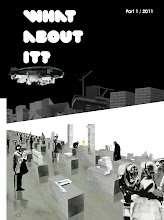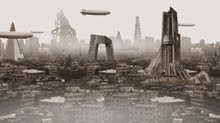What About a Kynical Narrative?
Narrative
Architecture: A Manifesto
Manifesto
There is a form of architecture that aims at not getting
built. An architecture on paper that should not be confused with paper
architecture. An architecture based on pure statements in which real brick,
mortar, and poured concrete are substituted by cut-and-pasted paper and
narrative prose. An architecture about the failed and accomplished ambitions of
buildings and master plans. An architecture that although focused on the
critique of this ambition, is not concerned with just any form of critique. An
architecture not preoccupied with the expert’s view in newspapers, nor the
common man’s comments on populist design blogs, nor the propaganda centrefolds of glossy magazines. An architecture that
talks directly to architecture about architecture. An architecture of
disciplinary struggle. This form of architecture focuses on the critique
of ideology, after recognizing that ideology – in its multiple incarnations –
has infiltrated all spheres of architectural production, including the sphere
of criticism itself. An architecture that through narrative texts and a vast
repertoire of images (collages, photomontages, drawings, storyboards, comic
strips, animations) – creates allegorical stories that aim to expose the impasse and
misfires of architecture in theory and practice. This form of architecture is
simultaneously both theory and practice. It is theory as practice; critique as
architectural project. This form of architecture is called Narrative
Architecture and this is its manifesto.
Coup
In order to be an effective tool against the seriousness of
architectural discourse, Narrative Architecture relies on the subversive power
of humor. It paints cheeky portraits
that parody through irony and sarcasm the shortcomings of ideology. Narrative
Architecture turns disillusion into mockery, disappointment into subversive
critique, pessimism into kynical
reason.1 It drills the sharpness of critique into the ossified shell
of hegemonic architectural discourse. Narrative Architecture is made out of
blown-up impostures. Its components are exaggerated characteristics innate to architecture. Architectural ambition
freed from the pragmatic distortions
of selective inhibition.
Although ostensibly heroic, Narrative Architecture is not
utopian. Its colossal monuments, impossible landscapes, and allegoric texts are
real depictions mirroring the absurd scenarios imagined by architectural
discourse. Narrative Architecture implies the sublime autonomy of theory.
Narrative Architecture is pure theory under a magnifying glass. It is
architecture as 'endless
supermarket',' continuous monument' and 'voluntary imprisonment'. Narrative
Architecture is the product of failed struggles and lost wars. It recognizes
its inability to ‘win’ the fight. It feeds from past, present, and future
failures. Because it learned that Team 10, Yona Friedman, and even
artist-turned-urbanist Constant failed to break from the modernist discourse
and the tools of its ideology, Narrative Architecture turns the tools of
ideology against themselves.
If Modernism used every medium available – publications,
architecture, urban plans, even CIAM as a platform to project its ideology– to shoot down the opposition, Narrative
Architecture points the ideological guns back at Modernism. When an
architectural position tries to consolidate itself as a hegemonic discourse and
avoids “coming voluntarily to the table of negotiation” with its opponents,
Narrative Architecture provokes “the polemical continuation of the miscarried
dialogue through other means”.2 Narrative Architecture summons the
dialectic properties of narrative in order to reestablish the conversation and
expose the lies. If architecture promises a city made of glittering white
concrete, Narrative Architecture casts the whole world in cement. If
architecture renders buildings behind curtains of dense green foliages,
Narrative Architecture depicts a universe contained in a forest of
skyscraping trees. If architecture decides to surf the waves of economic and
social indifference, Narrative Architecture projects a world washed away by a
neoliberal tsunami.
Narrative Architecture tackles every form of ‘enlightened
false consciousness’ and reveals what lies behind the disguising masks of
social impromptu and urban reconstruction; of the intoxicating greenery of
certified sustainability and neoliberalist social philanthropy, of the
aesthetic fantasies-turned urban oversimplifications of parametricism and other
momentary aesthetic trends; of the perverse reductionism of cartoonish diagrams
and immaculate renders.3 Narrative Architecture doesn’t shoot down
the banners and slogans of architectural discourse, it reads them aloud against
the ideological wind so as to reveal their absurdity.
Post Mortem
Because ideology presents concepts as their opposite – lies
as truth, opportunism as responsibility, self-consciousness as social
consciousness – it has condemned Narrative Architecture to the sterile
indifference of the museum wall, to the anesthetizing beauty of the art book.
However, Narrative Architecture belongs on the drawing board, on the computer screen, in
the architectural discussion. Narrative Architecture belongs to the present, to
the schools, to the practices. Narrative Architecture reveals the condition of
the zeitgeist,
now. If Ideology is doublethink, Narrative Architecture screams “down with Big
Brother”. While ideology is watching you, Narrative Architecture watches it
back. In a world driven by nonsensical statements, the most absurd of positions then becomes the clearest path. When
everything seems to stagnate, Narrative Architecture keeps moving.
1 The concept of ideology critique applied here is borrowed from Peter
Sloterdijk Critique of Cynical Reason
(1983). According to Sloterdijk Kynicism, as opposed to modern cynicism
(enlightened false consciousness), could be used as a strategy to destabilize
the hegemomic powers of the establishment. Kynicism consists often of humor
(through satire or irony) that attempts to highlight the impasse of absurd
intellectual postures in order to carry out an ideology critique. For more see
Peter Sloterdijk, Critique of Cynical
Reason, trans. Michael Eldred (Minneapolis: University of Minnesota Press,
1987).
2 “Enlightenment is reminded how
easily speaking openly can lead to camps and prisoners. Hegemonic powers cannot
be addressed so easily; they do not come voluntarily to the negotiating table
with their opponents, whom they would prefer to have behind bars.” (…) “Ideology
critique means the polemical continuation of the miscarried dialogue through
other means. It declares a war on consciousness, even when it pretends to be so
serious and ‘nonpolemical’”. Ibid
3 Thus, we come to our first
definition: “Cynicism is enlightened false consciousness.” Ibid.
What About WAI in Volume?
 |
| Volume 36 / Ways to be Critical / Summer 2013 |
WAI’s Manifesto of Narrative
Architecture and Blindness featured in Volume
Volume
Magazine has featured WAI Think Tank’s Narrative Architecture: A Manifesto,
and the printed version of Blindness, the second installment WAI’s animated
architectural narratives.
Abstract
from the editors of Volume:
“Ideology
in architecture is everywhere, infused in every I-beam, window panel and
overhang.
According
to Cruz Garcia and Nathalie Frankowski of What About It Think Tank (WAI),
ideologies are problematic posing concepts as their opposite, lies as truth,
opportunism as responsibility.
A vital
output of criticism is thus to expose the inner contradictions of ideology.
Working through allegorical stories and collage, WAI produce Narrative
Architecture as a means to expose such contradictions. In ‘Blindness’,
characters wander in a landscape of pure shapes, strangely captive to their
surroundings, seemingly without escape.”
 |
| Volume 36 / Ways to be Critical / Summer 2013 / Spread / WAI’s Narrative Architecture: A Manifesto |
Under the theme Ways to be Critical, Volume includes contributions
by Markus Miessen, Mimi Zeiger, Douglas Murphy, Michael Stanton, Justin McGuirk,
Luca Molinari, Naomi Stead, Demilit, Fred Scharmen, Charles Holland, Owen
Hatherley, Jan van Grunsven, Francoise Fromonot, Sergio Miguel Figueiredo,
Arjen Oosterman, Javier Arbona, Steve Parnell, Urte Rimsaite,Fabrizia Vecchone,
Nick Sowers, Koldo Lus (Klaustoon), Bryan Finoki, Rob Dettingmeijer, Bernard
Colebrander, Paul Walker, Jimenez Lai, Amelia Borg, Michele Champagne, Justine
Yan, Brendan Cormier, and Justine Clark.
Volume #36: Ways To Be Critical
144 pages
Binding: Soft-Cover
ISBN 978 90 77966 365
Price: € 19.50
Release: July 2013
Editor-in-chief: Arjen Oosterman
Contributing editors: Ole Bouman, Rem Koolhaas, Mark Wigley
Design: Irma Boom and Sonja Haller
Publisher: Stichting Archis
144 pages
Binding: Soft-Cover
ISBN 978 90 77966 365
Price: € 19.50
Release: July 2013
Editor-in-chief: Arjen Oosterman
Contributing editors: Ole Bouman, Rem Koolhaas, Mark Wigley
Design: Irma Boom and Sonja Haller
Publisher: Stichting Archis
 |
| Volume 36 / Ways to be Critical / Summer 2013 / Spread / Blindness |
What About Shapes, Islands and Text?
 |
| Cruz Garcia at the studio |
WAI, Garcia Frankowski and Vibok Works present Shapes, Islands, Texts
WAI directors will be publishing with Sevilla-based Vibok Works a limited edition numbered (100 copies) book presenting paintings, poetry, collages and short essays exploring the activity of Garcia Frankowski.
About the contents of the Book:
Like a conceptual tryptique, Shapes, Islands and Text presents three working tools that although having the capacity to function autonomously, once placed on the same space have the potential to create new narratives. The publication focuses on three spheres of equal importance. The vademecum presents: Shapes that are explored through multiple strategies –from monochromatic paintings to collages of pure geometries; conceptualIslands that are not only independent from any all-absorbing discourse but that one next to each other constitute theoretical archipelagoes; and Texts that sometimes are pure form and other times are independent like islands in the ocean.
To access the crowd-funding campaign for the limited edition book go Shapes, Islands, Text.
Publication Details:
Title: Shapes, Islands, and Text: a Garcia Frankowski Manifesto
Authors: Cruz Garcia, Nathalie Frankowski
Publisher: Vibok Works, INTELLIGENTSIA collection
Estimated Publishing Date: 1 / 12 / 2013
ISBN: 978-84-941464-7-3
Pages: 96 Dimmensions: 15x15 cm
Illustrations: Color
Languages: Spanish / English
Objective: Artist book of a limited edition numbered series of 100.
A version in spanish can be accessed here.
For more info on the work of Garcia Frankowski visit the webpage.
 |
| Nathalie Frankowski at the studio |
 |
| Twenty One Black Triangles on White Background, Oil on Canvas, 2013. |
What About the Poem of the Shapes?
Poem of the Shapes: Pure Hardcore Icons from WAI Think Tank on Vimeo.
Visual Poem for the Manifesto Pure Hardcore Icons
WAI Architecture Think Tank
Nathalie Frankowski & Cruz Garcia
Music Archie Shepp with Jasper Van't Hof / Mama Rose
Visual Poem for the Manifesto Pure Hardcore Icons
WAI Architecture Think Tank
Nathalie Frankowski & Cruz Garcia
Music Archie Shepp with Jasper Van't Hof / Mama Rose
What About WAI at the MoMA?
WAI featured at the Museum of Modern Art New York
Some of the projects and images of WAI Architecture Think Tank are going to be featured at the Cut ‘N’ Paste: From Architectural Assemblage to Collage City exhibition to be showcased at the Museum of Modern Art in New York. Organized by Pedro Gadanho ( Curator) and Phoebe Springstubb (Curatorial Assistant) the show features a selection of images that dissect the evolution of the architectural collage. The exhibition opens on July 10 and closes the 1st of December
From MoMA’s website:
The ethos of collage shapes every aspect of contemporary culture, from the glut of signs and images to the many layers of digital information to the art of sampling. This installation revisits early uses of collage to trace its evolution as both an aesthetic technique central to architectural representation and a cultural practice of layering, juxtaposition, and remix that configures the city. Opening with the seamless digital collages that dominate contemporary architectural practice, Cut ‘n’ Paste pairs the early photo-collages of Mies van der Rohe with avant-garde experiments in photomontage, graphic design, and film. Architectural thinkers Colin Rowe and Fred Koetter’s Collage City (1978), an urban manifesto for the medium, provides a backdrop through which to reframe contemporary uses. As an architectural tool, this wide-ranging medium mixes high and popular references and offers a dynamic, inventive connection to cultural context.
Subscribe to:
Posts (Atom)























